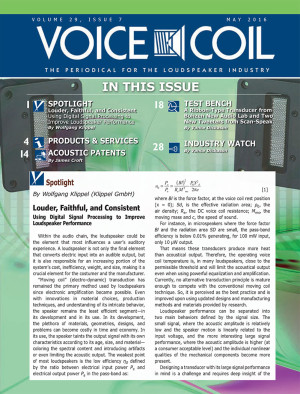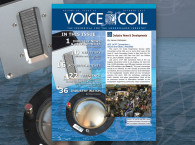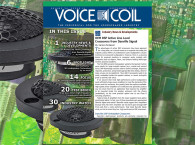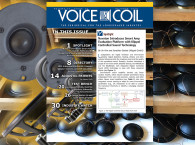 This issue of Voice Coil features an in-depth article by Wolfgang Klippel (Klippel GmbH), that describes “Using Digital Signal Processing to Improve Loudspeaker Performance” to achieve louder, faithful, and consistent results. This complete analysis in this month’s Spotlight is reference reading material for any loudspeaker designer and provides invaluable information on how to deal with loudspeaker inefficiencies.
This issue of Voice Coil features an in-depth article by Wolfgang Klippel (Klippel GmbH), that describes “Using Digital Signal Processing to Improve Loudspeaker Performance” to achieve louder, faithful, and consistent results. This complete analysis in this month’s Spotlight is reference reading material for any loudspeaker designer and provides invaluable information on how to deal with loudspeaker inefficiencies.As Wolfgang Klippel writes, “Designing a transducer with its large-signal performance in mind is a challenge and requires deep insight of the causes and effects of a loudspeaker’s nonlinear and thermal behavior. Since the 1980s, this topic has attracted the interest of more and more researchers, providing a reliable theoretical framework. The formalization of nonlinear and thermal parameters has opened a new path for loudspeaker diagnostics, as these parameters are able to describe the properties of the loudspeaker itself, independent of the applied stimulus (e.g., a test signal or music). Numerical simulation tools show the relationship between material, geometry, and nonlinear parameters, enabling the accurate modeling of both small and large signal behaviors.” Read on.
Next up is another valuable analysis of the latest Acoustic Patents, by our regular columnist and leading expert on the topic, James Croft (Croft Acoustical). This month, Voice Coil looks at an interesting acoustic device, recently patented by five inventors on behalf of Bose Corp. With a significant number of claims, the recently awarded patent describes “an acoustic device having a neck loop that is constructed and arranged to be worn around the neck. The neck loop includes housing that defines an acoustic volume, a first acoustic driver located at a first distal end of the housing and acoustically coupled to the housing, and a second acoustic driver located at a second distal end of the housing, opposite the first distal end and acoustically coupled to the housing.
As Croft comments, the disclosed invention includes a wearable acoustic device that directs sound to each ear without requiring acoustic drivers on, over, or in the ears. The device is configured to be worn around the neck and it has a “neck loop” with housing, such that the neck loop may have a horseshoe-like, or a “U” shape, with two legs that sit generally over each clavicle, and a curved central portion that sits behind the neck. Similar systems have been introduced in the past 20 years but unfortunately never found real applications but it might be different today. As Croft adds, “It is surprising that it has taken this long, but having experienced the format, I believe that many serious listeners will find a high-quality version of a Neck/Shoulder type system to be a surprisingly enjoyable means of personal listening. Given that, we may find Bose introducing another product category very soon.”
Also in May, Test Bench characterizes a ribbon-type transducer from Bozhen New Audio Lab and two new tweeters from Scan-Speak. Vance Dickason goes though those interesting new high frequency drivers, the first one of which is the CQ66, the next generation of Bozhen’s CQ76 ribbon tweeter (featured in Voice Coil’s April 2013 issue). From Scan-Speak, this Test Bench looks at two new beryllium dome tweeters, the D3004/60400 and the D3004/60400. Both tweeters use a Materion 26-mm 99% pure beryllium dome and basically share the same platform, with the major difference being the D3004/6010 has a lower Fs due to the larger rear cavity.
Also, important to note, this month’s analysis includes for the first time a contribution from Audiomatica. The CLIO Pocket has been added to the list of high-performance equipment used in the Voice Coil Test Bench column. The CLIO Pocket will supply a new graphic format, horizontal and vertical polar plots.
Finally, in Industry Watch, Voice Coil remembers the life and remarkable contributions of loudspeaker designer, audio researcher, and writer, Roy F. Allison (1927-2016). The last engineer and designer from the 1950s Acoustic Research (AR) days in Cambridge, MA, which gave birth to today’s consumer electronics industry with the first high-performance, affordable loudspeaker systems of acceptable size.
Note: Past issues of Voice Coil’s Test Bench can be found online here: http://audioxpress.com/categories/vc-testbench
This latest issue of Voice Coil - as well as previous archived editions - is available to read online or download here: www.gotomyvcoil.com
To download the new issue, renew your subscription, or qualify for a free subscription to Voice Coil, just go here: http://audioxpress.com/page/Voice-Coil-Subscriber-Services.html






